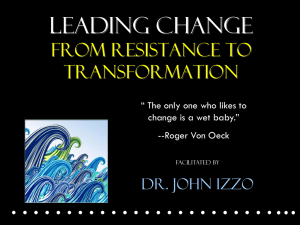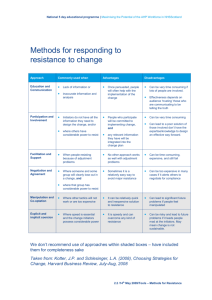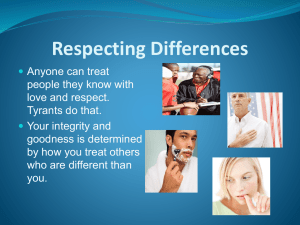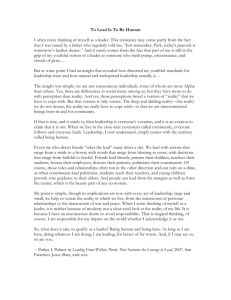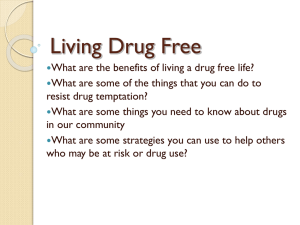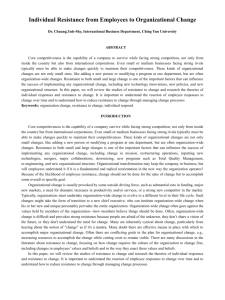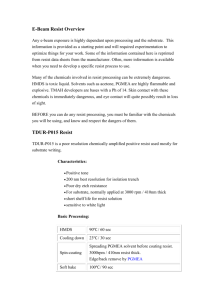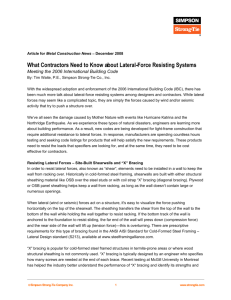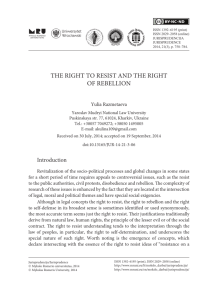“The Principles of Instantaneous Transformation”
advertisement
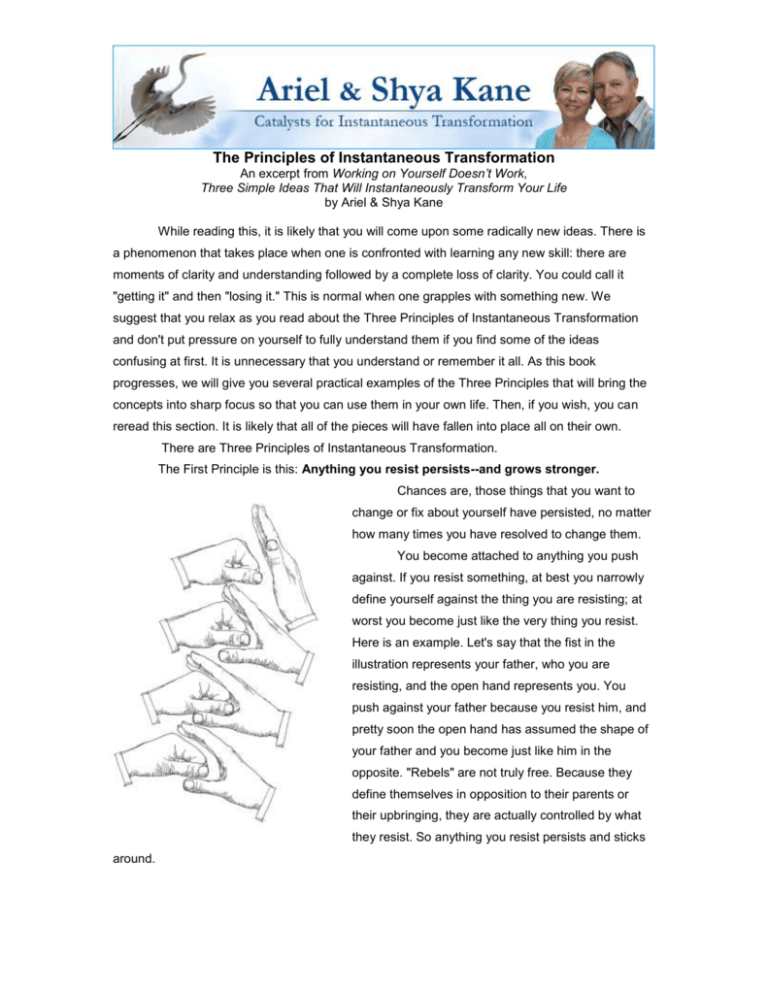
The Principles of Instantaneous Transformation An excerpt from Working on Yourself Doesn’t Work, Three Simple Ideas That Will Instantaneously Transform Your Life by Ariel & Shya Kane While reading this, it is likely that you will come upon some radically new ideas. There is a phenomenon that takes place when one is confronted with learning any new skill: there are moments of clarity and understanding followed by a complete loss of clarity. You could call it "getting it" and then "losing it." This is normal when one grapples with something new. We suggest that you relax as you read about the Three Principles of Instantaneous Transformation and don't put pressure on yourself to fully understand them if you find some of the ideas confusing at first. It is unnecessary that you understand or remember it all. As this book progresses, we will give you several practical examples of the Three Principles that will bring the concepts into sharp focus so that you can use them in your own life. Then, if you wish, you can reread this section. It is likely that all of the pieces will have fallen into place all on their own. There are Three Principles of Instantaneous Transformation. The First Principle is this: Anything you resist persists--and grows stronger. Chances are, those things that you want to change or fix about yourself have persisted, no matter how many times you have resolved to change them. You become attached to anything you push against. If you resist something, at best you narrowly define yourself against the thing you are resisting; at worst you become just like the very thing you resist. Here is an example. Let's say that the fist in the illustration represents your father, who you are resisting, and the open hand represents you. You push against your father because you resist him, and pretty soon the open hand has assumed the shape of your father and you become just like him in the opposite. "Rebels" are not truly free. Because they define themselves in opposition to their parents or their upbringing, they are actually controlled by what they resist. So anything you resist persists and sticks around. If you want a more scientific explanation of this principle, it goes something like this: For every action there is an equal and opposite reaction. The Second Principle is also a rule of physics: No two things can occupy the same space at the same time. For example, if a person is sitting in a chair, no other person can sit in that exact spot in that same chair at the exact same time. In the case of emotions, you cannot be happy if you are actually sad--no two emotions can occupy the exact same space at the exact same time. If you are seated while you are reading this page, you will discover that you can only be seated in this moment of now. We all have been taught that we can improve our lot in life. But in this very moment of now, you can only be exactly as you are. Striving to attain an idea or an ideal is akin to saying the way you are is imperfect or flawed. You may have the idea that you can be different, but in reality, in this moment, you are the way you are. If we were to take a photograph of you, at the moment the picture was taken you could only have been the way the camera captured you in that moment. You can't change the way you were. Life shows up in a series of moments of now, and in this moment of now you can only be exactly the way you are--and that is the Second Principle. The Third Principle is as follows: Anything that you re-create or have be exactly as it is will complete itself and disappear. In other words, if you let things actually be the way they are, without trying to change them or fix them, without judging them as good or bad or right or wrong, they complete themselves and disappear. This includes psychological, physiological, and emotional pain as well as upsets. If you let yourself be upset when you are upset rather than trying to get rid of the feeling (First Principle: what you resist persists), then it will dissolve all on its own and disappear. Have you noticed that happiness is fleeting? Do you resist it when it happens? Do you say, "Oh, no, I'm happy again. I was hoping this happiness wouldn't overtake me"? Happiness is not one of those things we usually resist. So it goes really quickly. But if we're upset or sad, these states have a tendency to linger because we generally don't want to be upset when we are upset or sad when we are sad. Disagreeing with how your life is showing up in this moment is a form of resistance. And don't forget, resistance results in the unwanted condition's persistence. Look at your life--hasn't everything that you've tried to get rid of stuck around on some level? Those things that you push against, when you've said, "I've got to change. I shouldn't be like that," don't resolve. That's the First Principle. Again, the Second Principle is "No two things can occupy the same space at the same time." In other words, if you allow yourself to feel what you're feeling when you're feeling it (that's the Third Principle), it will clear up; it will disappear. Awareness, a nonjudgmental investigation, can free you from old patterns--even things that have gone on for years, that you've resisted, that you've tried to get rid of and have had New Year's resolutions about. If you allow yourself to simply be with anything, it loses its power over you. However, if you resist an old pattern of behavior, you give it power over your life. We are suggesting a way of being that involves surrendering to your life, not resisting the way your life shows up in each moment. Your life presents itself the way it does. It doesn't show up any differently. Again, you can't be standing when you are sitting. Now what you do with the way your life is showing up is up to you. Let's come back to the First Principle. If you resist circumstances in your life, they persist. If on the other hand you simply notice your circumstances, without judging what you see, if you just say, "Oh, this is the way my life is, OK," then unwanted patterns complete themselves. However, you cannot "accept" something as a means to get rid of it, change it, or fix it. This is not acceptance at all. In actuality, acceptance with an agenda to change the situation is a manipulation to get to what you want rather than experiencing or being with what you have. Transformation doesn't work that way. But if you actually, genuinely choose to have what you have when you have it, it disappears. When you allow yourself to be the way you are, and notice how you are being without judging yourself, a phenomenon takes place called completion. In other words, if you notice the way you behave without trying to change or fix yourself and without judging what you discover, those behaviors that you have been trying to change or ways of being that you have been putting up with will complete themselves, just with awareness. But you can't notice it to get rid of it, because that throws you back into the First Principle--anything you resist persists and grows stronger. You can think of awareness like taking a block of ice and letting it sit in the sun. The radiant heat of simple awareness is enough to melt old, frozen mechanical behaviors. ============================ About the Authors: Since 1987, internationally acclaimed authors, seminar leaders, and business consultants Ariel and Shya Kane have acted as guides, leading people through the swamp of the mind into the clarity and brilliance of the moment. Their new book, Working On Yourself Doesn't Work: The Three Simple Ideas That Will Instantaneously Transform Your Life, is now available. To find out more about the Kanes and their Transformational Community or to sign up to receive their article of the month, visit their Web site at: www.TransformationMadeEasy.com.
